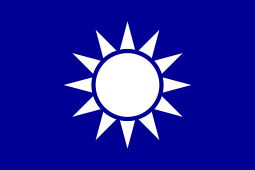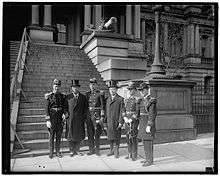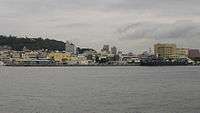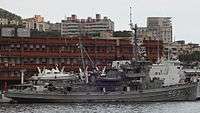Republic of China Navy
| Republic of China Navy 中華民國海軍 Zhōnghuá Mínguó Hǎijūn | |
|---|---|
_Logo.svg.png) | |
| Active | 1924–present |
| Country |
|
| Type | Navy |
| Size |
38,000 personnel 117 ships |
| Part of | Republic of China Armed Forces |
| Colors | white |
| Website | navy.mnd.gov.tw (English) |
| Commanders | |
| Commander-in-chief |
|
| Deputy Commander-in-chief |
|
| Deputy Commander-in-chief |
|
| Insignia | |
| Ensign |
 |
| Jack |
 |
The Republic of China Navy (ROCN; Chinese: 中華民國海軍; pinyin: Zhōnghuá Mínguó Hǎijūn) is the maritime branch of the Republic of China Armed Forces. The ROC Navy's primary mission is to defend ROC territories and the sea lanes that surround Taiwan against a blockade, attack, or possible invasion by the People's Liberation Army of the People's Republic of China. Operations include maritime patrols in the Taiwan Strait and surrounding waters, as well as counter-strike and counter-invasion operations during wartime. The Republic of China Marine Corps functions as a branch of the Navy.
The ship prefix for ROCN combatants is ROCS (Republic of China Ship); an older usage is CNS (Chinese Navy Ship).
Organization
Republic of China Navy Command Headquarters (中華民國國防部海軍司令部)
- Navy CHQs is subordinate to the General Staff, the Minister of Defense, and the ROC President.
- Internal units: Personnel, Combat Readiness & Training, Logistics, Planning, Combat Systems, General Affairs, Comptroller, Inspector General, Political Warfare.
- Naval Fleets Command (艦隊指揮部)
- 124th Fleet: Zuoying District, Kaohsiung City
- 131st Fleet: Keelung City, Taiwan Province
- 146th Fleet: Magong City, Penghu County, Taiwan Province
- Amphibious Fleet (151st Fleet), Zuoying District, Kaohsiung City
- 168th Fleet: Suao, Yilan County, Taiwan Province
- 192nd Fleet (Navy Minesweeper Fleet): Zuoying District, Kaohsiung City
- 256th Submarine Squadron: Zuoying District, Kaohsiung City
- 261st Squadron
- Hai Chiao(Sea Dragon) PGMG Guided Missile Boat/Craft Group (海蛟大隊)
- 1st Hai Chiao Guided Missile Boat/Craft Squadron of 10 Kuang Hua VI-class missile boat at Suao naval base
- 2nd Hai Chiao Guided Missile Boat/Craft Squadron of 10 Kuang Hua VI-class missile boat
- 3rd Hai Chiao Guided Missile Boat/Craft Squadron of 10 Hai Ou-class missile boat (Dvora class)
- 4th Hai Chiao Guided Missile Boat/Craft Squadron of 10 Hai Ou-class missile boat (Dvora class)
- 5th Hai Chiao Guided Missile Boat/Craft Squadron of 11 Kuang Hua VI-class missile boat[2][3]
- Hai Feng Shore Based Anti-ship Missile Group (海鋒大隊), operates 6 batteries of fixed/mobile HF-2 anti-ship missiles.
- Aviation Command (operates from Pingtung, Tsoying, and Hualien AB)
- Naval Aviation, at Pingtung, will receive 12 P-3C 2013/2014.
- 1st ASW Aviation Group
- 133rd Squadron: S-2T, at Pingtung.
- 134th Squadron: S-2T, at Pingtung.
- 2nd ASW Aviation Group
- 701st Helicopter Squadron (Light), S-70C(M)-1, at Hualien.
- 702nd Helicopter Squadron (Light), S-70C(M)-2, at Tsoying.
- 501st Helicopter Squadron (Light), 500MD ASW, at Tsoying.
- Maintenance Group
- 1st Maintenance Squadron (Pingtung)
- 2nd Maintenance Squadron (Tsoying)
- 3rd Maintenance Squadron (Hualien)
- Marine Corps Command (陸戰隊指揮部)
- Education, Training and Doctrine Command (教育訓練暨準則發展司令部)
- Logistics Command (後勤司令部)
- Naval Academy, Hydrographic & Oceanographic Bureau, Shipbuilding Development Center, Communication Systems, General Service.
History
| ||||||||||||||||
1914–1949
See also Naval history of China

The precursor to the modern ROC Navy was established as the Ministry of the Navy in the Provisional Government of the Republic of China in 1911 following the overthrow of the Qing dynasty. During the period of warlordism that scarred China in the 1920s and 1930s the ROCN remained loyal to the Kuomintang government of Sun Yat-sen instead of the warlord government in Beijing. During that time and throughout World War II, the ROCN concentrated mainly on riverine warfare as the poorly equipped ROCN was not a match to Imperial Japanese Navy over ocean or coast.[10]
Following World War II, a number of Japanese destroyers and scrapped U.S. ships were transferred to the ROC Navy. During the Chinese Civil War, the ROCN was involved in the protection of supply convoys and the withdrawal of the ROC Government and over 1 million refugees to Taiwan in 1949. The subsequent reorganization and reestablishment of the Navy after evacuation to Taiwan is referenced in the lyrics of the post 1949 ROC Navy Song "The New Navy" (新海軍).
1949–Present
Following the relocation of the ROC government to Taiwan, the ROCN was involved in a number of commando attack escorts, evacuation and transport of more displaced soldiers and later to provide patrols and resupply operations to Kinmen and Matsu in the Taiwan Strait and South China Sea offshore islands.
Since the 1990s the Navy has grown in importance as the emphasis of the ROC's military doctrine moves towards countering a possible People's Republic of China (PRC) blockade, as well as offshore engagement. The ROCN has been working hard to expand its capability in electronic and anti-submarine warfare, as well as the replacement of its current antiquated fleet.[8] However local shipbuilder CSBC still lacks the technology to build modern submarines.[11]
Equipment

Traditionally, most ROCN equipment is purchased from the United States, though several ships have been built domestically under licence or through domestic development. The ROCN has also purchased Lafayette-class frigates from France and Zwaardvis-class submarines from the Netherlands as well as four U.S. Kidd-class (renamed Keelung) destroyers originally intended for Iran.
Despite the ROCN refurbishing and extending the service life of its vessels and equipment, it has suffered from procurement difficulties due to pressures exerted by the PRC. It has only two useful submarines. The U.S. has approved sales of eight new diesel powered submarines but lacks the manufacturing capability to make the engines; at the same time, threats from the PRC prevent the necessary technology transfer from other countries. Furthermore, the Legislative Yuan did not approve the budget and thereby slowed the opportunity to procure the badly needed underwater defense capability.
In 2003 the US Government suggested buying four Nazario Sauro-class refurbished submarines from Italy, that reportedly agreed to sell them plus an additional four other submarines, following their decommissioning by the Italian Navy. However, Taipei rejected the offer, saying it wanted new submarines
On 12 September 2007, an arms notification was sent to the United States Congress concerning an order for 12 P-3C Orion patrol aircraft and 3 "spare aircraft", along with an order for 144 SM-2 Block IIIA surface-to-air missiles.[12] A contract was awarded to Lockheed Martin to refurbish the 12 P-3C Orion aircraft for the ROC on 13 March 2009, with deliveries to start in 2012.[13]
In 2008, the ROCN set out to acquire an improved anti-ship capability. On 26 August, an arms notification was sent to Congress for an order for 60 air-launched Harpoon Block II missiles for the 12 P-3C.[14] At least a portion of these missiles will be installed on the navy's Hai Lung-class submarines.
On 29 January 2010, the U.S. government announced 5 notifications to the U.S. Congress for arms sales to the ROC. In the contracts total 6.392 billion USD, ROC Navy will get 2 Osprey-class minehunters for 105 million USD, 25 Link 16 terminals on ships for 340 millions, 10 ship- and 2 air-launched Harpoon L/II for 37 million USD.[15][16]
The ROC Navy already has 95 older Harpoon missiles in its inventory for the 8 Knox-class frigates, 22 newer RGM-84L for the 4 Kidd-class destroyers, 32 sub-launched Harpoon II on order for the 2 Hai Lung-class submarines, and with 60 air-launched Harpoon Block II anti-ship missile on order for the 12 P-3Cs, plus the newly announced 10 ship-launched and 2 air-launched Harpoon II/L sales.[17]
On 31 August 2010, it was announced for next year's defense budget, ROCN planned to lease 1 or 2 more Newport-class tank landing ships (LST) from the United States, but the 900-ton stealth corvette plan was put on hold, due to lack of funds.[18] That same year, On 29 September, the U.S. Congress passed a resolution, authorizing the U.S. Government for the sale of 1 more Osprey-class minehunter to the ROC.[19]
Other ongoing local upgrade programs include locally designed and built Ching Chiang class of 12 patrol ships that were designed back in the 1990s to carry 4 HF-1 anti-ship missiles on board but only the lead ship of the class had them. Since 2006, 7 ships of this class were upgraded to carry 4 HF-2/3 with W-160 fire control radar from Wu Chin III program (as well as Honeywell H-930 MCS CDS stripped from 7 retired Yang class Wu Chin 3 anti-air warfare destroyers). In 2010 more ships of this class were undergoing this same upgrade program but using CSIST produced fire control radars instead. Currently 4 different variants exist within this class, the original Ching Chiang patrol ship constructed with 4 HF-1 (1 existing in this configuration).
On 29 December 2010, 2 LSTs (中肇、中治戰車登陸艦) and 4 remaining of Adjutant-class coastal minehunters were retired.[20]
In 2011, the navy retired several vessels. On 31 October, all 8 PCL in the 124th Fleet were retired.[21] On 28 December, the 2 Lung Jiang-class (PSMM Mk5) guided missile patrol boats (PGG 601 and PPG 602) of the 131st Fleet were retired from ROC Navy service, after entering service in 1978 and 1981 respectively.[22]
On 15 April 2014, the Defence Minister Yen Ming announced that the United States will help Taiwan to build its own diesel-electric attack submarines (SSKs). Taiwan is looking to build eight submarines indigenously whilst also actively seeking to purchase diesel-electric submarines from other nations. The submarines would greatly improve the Navy's defensive capabilities.[23] It has been reported that in November 2014 Taiwan will announce a 20-year modernisation plan to replace the entire fleet. The plan is for four destroyers of 10,000 tons, 10–15 catamaran frigates of 3,000 tons, new amphibious ships and 4–8 submarines of 1,200–3,000 tons. The submarines may be built with a foreign partner but the surface ships would all be domestic designs.[24]
Vessels
| Destroyers (4 in service) | |||||
|---|---|---|---|---|---|
| Class | Origin | Type | In service | Notes | |
| Kee Lung-class | destroyer | 4 | Ex-Kidd-class-class | ||
-
_and_Ma_Kong_(DDG-1805)_shipped_in_Zhongzheng_Naval_Base_20130504b.jpg)
Kee-Lung-class
| Frigates (20 in service) | |||||
|---|---|---|---|---|---|
| Class | Origin | Type | In service | Notes | |
| Cheng Kung-class | frigate | 8 | Licensed version of long hull Oliver Hazard Perry-class. | ||
| Chi Yang-class | frigate | 6 | Ex-Knox-class | ||
| Kang Ding-class | | frigate | 6 | French-built La Fayette-class | |
-

Cheng Kung-class
-

Chi Yang-class
-

Kang Ding-class
| Fast Attack Missile Crafts (31 in service) | |||||
|---|---|---|---|---|---|
| Class | Origin | Type | In service | Notes | |
| Kuang Hua VI-class | | missile boat | 31 | Delivery began 2003 | |
-

Kuang Hua VI-class
| Submarines (2 in service) | |||||
|---|---|---|---|---|---|
| Class | Origin | Type | In service | Notes | |
| Chien Lung-class | diesel-electric submarine | 2 | Based on Zwaardvis-class submarine and entered service in 1987–1988. | ||
| Hai Shih-class | diesel-electric submarine | 1 | Training, ex-USS Cutlass (SS-478) | ||
| Hai Bao-class | | diesel-electric submarine | 1 | Training, ex-USS Tusk (SS-426) | |
-

Hai Lung-class
-
Hai Shih-class
| Patrol Ships (13 in service) | |||||
|---|---|---|---|---|---|
| Class | Origin | Type | In service | Notes | |
| Ching Chiang-class | | patrol ship | 12 | naval Kuang Hua III program | |
| Tuo Chiang-Class | | corvette | 1 | on 14 March 2014. [25] | |
-
Ching Chiang-class
-

Tuo Chiang-class
| Minesweepers (9 in service) | |||||
|---|---|---|---|---|---|
| Class | Origin | Type | In service | Notes | |
| Yung Feng-class | | minesweeper | 4 | ex-MWW-50 class | |
| Yung Yang-class | minesweeper | 3 | ex-Aggressive class | ||
| Yung Ching-class | | minesweeper | 2 | ex-Osprey class | |
-
.jpg)
Yung Yang-class
-
_Shipped_in_Zhongzheng_Naval_Base_20130504a.jpg)
Yung Ching-class
| Amphibious Ships (10 in service) | |||||
|---|---|---|---|---|---|
| Class | Origin | Type | In service | Notes | |
| Newport-class | | tank landing ship | 2 | ex-USN USS Manitowoc (LST-1180) and USS Sumter (LST-1181) | |
| Chung Hai-class | | tank landing ship | 6 | Landing Ship, Tank (LST-1) | |
| Kaohsiung-class | | tank landing ship | 1 | ex-USS Dukes County (LST-735) LST-542 class tank landing ship | |
| Shi Hai-class | | dock landing ship | 1 | ex-USS Pensacola (LSD-38) Anchorage-class dock landing ship | |
-

Newport-class
-

Chung Hai-class
-

Kaohsiung-class
-

Shi Hai-class
| Auxiliary Ships (10 in service) | |||||
|---|---|---|---|---|---|
| Class | Origin | Type | In service | Notes | |
| Pan Shi-class | | fast combat support ship | 1 | AOE-532 | |
| Wu Yi-class | | fast combat support ship | 1 | AOE-530 | |
| Ta Kuan-class | | research ship | 1 | oceanographic measurement | |
| Ta Hu-class | rescue and salvage ship | 2 | ARS-552 (ex-USS Grapple) | ||
| Ta Tung-class | fleet tug | 5 | ATF-548 (ex-USS Chickasaw) | ||
-
.jpg)
Pan Shi-class
-
Wu Yi-class
-
Ta Kuan-class
-

Ta Hu-class
-

Ta Tung-class
Aircraft
| Aircraft (28 in service) | |||||
|---|---|---|---|---|---|
| Aircraft | Origin | Type | In service[26] | Notes | |
| Sikorsky S-70C(M)-1/2 Thunderhawk | | SAR ASW Naval utility helicopter | 19 | Out of 10+11 ordered | |
| Hughes 500MD/ASW Defender | | ASW Naval utility helicopter | 9 | Out of original 13 ordered | |
| Lockheed P-3C Orion | | Maritime patrol aircraft | 12 | Re-built ex-US Navy aircraft and replaced ROCN Grumman S-2 Trackers | |
| Lockheed EP-3E Orion | | signals reconnaissance | 3 | Spare P-3C airframes acquired for future conversion to EP-3E Aries I of II platform | |
Marine Corps
Republic of China Marine Corps:
See ROC Marines for details on infantry weapons, vehicles, artillery, missiles, helicopters.
Procurement
2 Oliver Hazard Perry-class frigates to be ordered.[27][28][29]
Bases
- Tsoying Naval Base – 1st Naval District HQ, largest naval base in Taiwan and naval airfield near Kaohsiung
- Tsoying Naval Airfield and Naval Yard – Tsoying District
- Makung Naval Base (Makung, Pescadores) – 2nd Naval District HQ – home to attack squadrons, training centre and naval yard
- Keelung Naval Base, Keelung – 3rd Naval District HQ, home to northern patrol and transport squadrons and small naval yard
- Suao Naval Base, Su-ao, Yilan – East Coast Command and supports Keelung Naval Base
All remaining bases are small naval stations supporting PCL class small patrol boats and Fast Attack Boat:
- Anping Naval Base, Anping
- Hsinchu Naval Base, Hsinchu
- Hualien Naval Base, Hualien
- Kenting Naval Base, Hengchun
- Tamshui Naval Base, Tamshui
- Wu Chi Naval Base, Wuqi District
See also
- List of active Republic of China Navy ships
- Ministry of National Defense (Republic of China)
- Republic of China Armed Forces
- Republic of China Army
- Republic of China Air Force
- Republic of China Military Police
- Republic of China Naval Academy
- People's Liberation Army Navy
- Political status of Taiwan
- Republic of China Navy rank and rating insignia for the rank and rating system of the ROCN (Marine Corps included)
References
- ↑ "New defense minister urges alert over Chinese espionage". focustaiwan.tw. Retrieved 30 January 2016.
- ↑ "First KH-6 squadron entered service as 5th Sea Dragon Squadron". Central News Agency. Retrieved 2010-05-18.
- ↑ "First KH-6 squadron entered service". pchome.com.tw. Retrieved 2010-05-18.
- ↑ "Red Roof Tiles and White Walls, Hidden Missile Base Next To Hotel.". United Daily News. Retrieved 2010-12-23.
- ↑ "Navy opens missile base in eastern Taiwan to media". The China Post. Retrieved 2010-12-23.
- ↑ "ROC Navy opens missile base in eastern Taiwan to media". China Defense Blog. Retrieved 2010-12-23.
- ↑ "Navy – Overview". GlobalSecurity.org. Retrieved 2006-03-08.
- 1 2 "2004 National Defense Report" (PDF). ROC Ministry of National Defense. 2004. Archived from the original (PDF) on March 11, 2006. Retrieved 2006-03-05.
- ↑ "Combat Units Under the ROC Navy Fleet HQ". Taiwanmilitary.org. Retrieved 2006-03-08.
- ↑ "歷史傳承 (History)". ROC Navy. Retrieved 2006-03-08.
- ↑ "Navy questions CSBC's capability to build submarines" ROC Central News Agency. March 14, 2012.
- ↑ "Pentagon could make 2.2 billion dollar arms sales to Taiwan". Yahoo! news. 2007-09-13. Retrieved 2007-09-13.
- ↑ "U.S. in deal to refurbish aircraft for Taiwan". Washington Post. 2009-03-13. Retrieved 2007-09-13.
- ↑ Jennings, Ralph (2008-08-27). "U.S. to sell anti-ship missiles to Taiwan". Reuters.
- ↑ "USDA New Release" (PDF). dsca.mil. 2010-01-29. Archived from the original (PDF) on 2011-07-21. Retrieved 2010-01-29.
- ↑ "USDA New Release" (PDF). dsca.mil. 2010-01-29. Archived from the original (PDF) on 2011-07-21. Retrieved 2010-01-29.
- ↑ "armstrade.sipri.org". armstrade.sipri.org. Retrieved 2010-01-10.
- ↑ "Next Year Defense Budget Believed To Be Lowest In 5 Years". United Daily newspaper. 2010-08-31. Retrieved 2010-09-12.
- ↑ "US Congress approved sales of mine hunter to Taiwan". United Daily News. 2010-09-30. Retrieved 2010-09-30.
- ↑ "6 Navy ships retired.". Youth Daily News. 2010-12-29. Retrieved 2010-12-29.
- ↑ "All 8 Navy PCL Retired Into History.". Military News Agency. 2011-10-31. Archived from the original on 2012-04-25. Retrieved 2011-11-01.
- ↑ "2 Lung Jiang Missile Guided Patrol Boats Retired". United Daily News. 2011-12-28. Retrieved 2012-01-03.
- ↑ "US to Help Taiwan Build Attack Submarines.". The Diplomat. 2014-04-15. Retrieved 2014-10-30.
- ↑ Minnick, Wendell (20 September 2014). "Taiwan Previews Major Naval Acquisition Plan". Defense News.
- ↑ http://www.janes.com/article/35351/taiwan-launches-first-carrier-killer-stealth-missile-corvette
- ↑ "Naval Aviation Command". Globalsecurity.org. Retrieved 2007-07-16.
- ↑ "US plans to sell warships to Taiwan". Yahoo News. Retrieved 2015-12-17.
- ↑ Pike, John. "Taiwan to buy Perry-class frigates from U.S.". globalsecurity.org. Retrieved 4 July 2016.
- ↑ "Taiwan's Force Modernization: The American Side". Defense Industry Daily. 21 July 2015. Retrieved 30 January 2016.